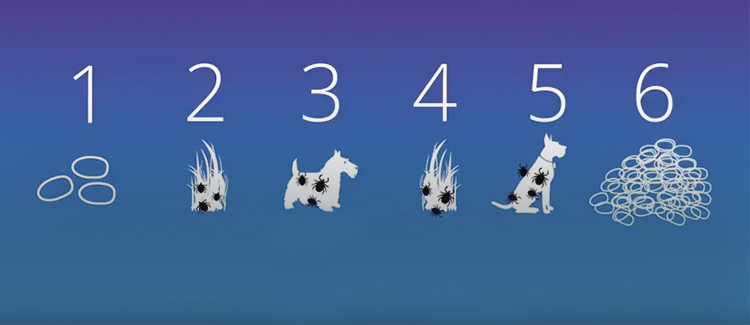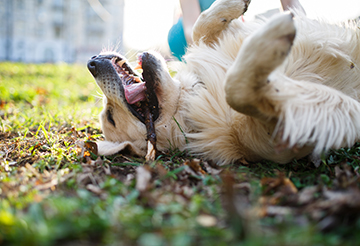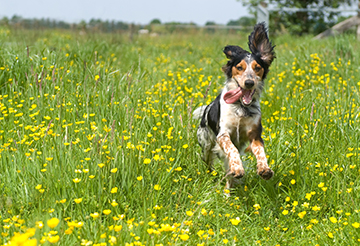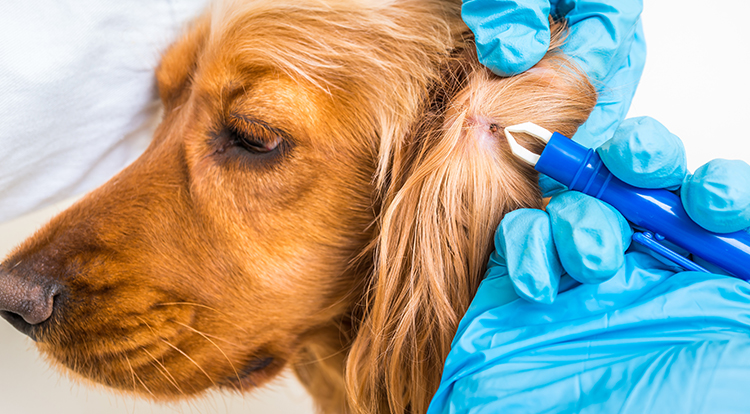6 Signs your Dog has Ticks
TICKS ON DOGS

Posted by bravectosouthafrica – 01 February 2018
Topics covered in this article/blog:
6 Signs to look out for if your dog has ticks
What do ticks look like on dogs?
When should you start to worry?
Symptoms that your dog might be suffering from Biliary
What makes your dog tick?
What should you do if your dog has ticks?
Should you be using pesticides?
Are you getting ticked-off?
6 Signs to look out for should your dog have ticks
Before looking out for signs in your dog should your dog have ticks, it is important to have general and frequent routine checkups to ensure your dog is tick free. If there aren’t any visible ticks on your dog, here are 6 signs to look out for should your dog have ticks.
First sign to look for should your dog have ticks: Frequent head shaking.
If your dog is shaking its head more than usual, there could be something that is irritating your pet. In this case, that something could be a tick. Ticks like to hide out in warm, damp places. Frequent head shaking could mean that your dog has a tick staying in his ear canal. If this sounds like something your dog has been doing, the first step will be to take a flashlight and peek into your dog’s ear to see if you can find any new tenants staying in his ear, however, it would be best to take your dog to the vet.
Second sign to look for should your dog have ticks: Mysterious Scabs
Fair enough, your dog is a playful animal and you can’t always watch his every move or account for all the small things your dog gets up to during the day. However, if you see an abnormal amount of unexplained scabs, make sure to take a closer look. These scabs could be a bite spot or a previous tick that your dog scratched or bit off. Because your dog probably didn’t stop and take the time to consider the medically safe procedure to remove ticks, the bite site could get infected. Your dog might also be biting or scratching at the bite site, which could require you to get treatment as soon as possible.
Third sign to look for should your dog have ticks: A Fever
Signs of your dog having a fever include a sudden loss in appetite, general weakness as well as shivering and out of the ordinary panting. If you are unsure about whether or not your dog is showing signs of a fever, or just being generally moody – use a lubricated thermometer to take the rectal temperature of your dog. If it’s somewhere below 39 °C , your dog does not have a fever – merely apologise for the uncomfortable temperature taking and see if there might be other factors contributing to your dog’s abnormal behaviour. If you are concerned that your dog may be ill, the best thing to do is to take your dog to the vet.
Fourth sign to look for should your dog have ticks: Your dog’s behaviour
One of the ways to spot whether or not your dog is playing host to one (or a few) ticks, will be in their attitude. If your dog is generally acting more edgy than normal and is frequently scratching at his or her ears, eyes, neck or biting their feet, it could be a sign that you might want to investigate a little further.
Fifth sign to look for should your dog have ticks: You spot a tick around your house
If you spot a tick around your house, it should be a clear sign that they have either already – or are very close to making themselves at home on your dog or even you.
Sixth sign to look for should your dog have ticks: Areas that appear red or irritated
If your dog’s skin seems red or irritated in some places, be sure to check if it’s due to scratching, or a more severe issue. When ticks are removed incorrectly, the head of the tick can remain in the dog’s skin after removal. If the head is not taken out correctly, it could cause your dog’s skin to get red and irritated.

What do I do if I find a tick on myself?Download the 8 steps to de-ticking yourself HERE
What do ticks look like on dogs?
Spotting ticks on dogs can be a tricky task. Ticks aren’t always clearly visible on your dog, especially if you have a particularly furry friend. Finding and removing ticks on your dog is an important part of any pet owner’s life. Catching them in time, however, can prove to be hard when the ticks are still tiny.
It’s advisable to run your hands through your dog’s fur every now and then. This doesn’t only mean some extra petting time to emotionally support your dog and the stress of (maybe) having a tick or two, but also allows you to feel for any small bumps on your dog’s skin. If you feel a small bump, try not to ignore it or solve the situation by denial – but rather investigate further by parting your dog’s fur and getting a closer look to see if what you are feeling (besides anxiety) is a tick or not.
Okay, so now you’ve parted the fur but you’re not quite sure what you’re even looking for or what it is that you found. To avoid having to get so close to said tick that you make eye-contact and share a brief connection with the creepy crawler – there are some basic ways to identify a tick, as well as a few signs to look out for should your dog have a tick or not.
Common characteristics of ticks include having a spider-like resemblance. Ticks are oval-shaped and vary in size. Usually, they are 1 mm – 1 cm long but will grow larger over time as they feed. Ticks can be greyish, brown, black or reddish-brown in colour and will become darker as they mature and fill with blood. Ticks can be found camping out around your dog’s head, neck, ears and feet. Although ticks fall off their host at different stages of their life cycle, the problem or risk of infection will not disappear with the tick. If the tick disappears, there is still a chance that your dog might get an infection at the bite area or fall victim to a tick-borne disease. A tick feeds by sucking out blood from its host. Therefore, the quicker you can get rid of it in a safe and correct way, the chances of your dog suffering from any tick-related disease will decrease.

Want to know more about ticks?
Download the 6 part life cycle of a tick to learn more.
When should you start to worry?
One of the more common diseases associated with ticks in dogs in South Africa is Tick Fever – Biliary fever.
Ticks are carriers of diseases, and if left too long, the chances of your dog getting a tick-borne disease is much higher. The most common disease in South Africa caused by these little and not so little critters is Canine Babesiosis (Biliary Fever) or colloquially known as ‘tick fever’. Tick Fever is caused by a tiny parasite called ‘Babesia canis’ that is introduced to your dog’s body from a tick bite. This disease causes anaemia as your dog’s red blood cells are destroyed by the rapidly dividing parasites within them.
Most dogs only suffer from the more acute or subacute forms of Tick Fever. However, both the acute and severe forms of ‘Biliary Fever’ in dogs, can be fatal. Therefore, it is absolutely crucial that you educate yourself on the early symptoms and signs of the disease.
Symptoms that your dog might be suffering from Tick Fever:
When your dog has a temperature of 39 °C or higher, it could indicate that it’s time to take your dog to the vet.
If however, you have managed to catch your dog’s fever in time, this means that your dog is still actively fighting the parasite infection – which is a good thing. If you postpone your trip to the vet for too long you might miss out on crucial treatment time. If your dog’s mucous membranes are turning pale, white or yellow, your dog might already be experiencing the more advanced stages of the disease. During this time, it is important to look for other signs like, yellow poop, red urine, pale gums, listless or lethargic behaviour and a rapid heartbeat.
Generally, it is difficult to spot the symptoms of tick-borne diseases in your dog before clinical signs occur. If left untreated, your dog may start to show more advanced signs which can include loss of appetite, depression, reluctance to move, severe lethargy, deep laboured breathing or panting and a weak pulse.
If your dog is showing any of the symptoms above, it is of the utmost importance to contact your nearest vet immediately.
What makes your dog tick?


We know that dogs get ticks or fleas at some point in their life, but how do they become home to these unwelcomed hitchhikers?
Their Furry Friends and Foes
There is always a chance of ticks being transmitted when your dog comes into contact with other animals. It is important to keep wild animals such as squirrels or strays away from your dog to ensure your dog is healthy and not a medium for tick transportation.
Travelling
As a pet owner, you can also carry ticks and bring them back home with you while travelling. If you are a person who enjoys the outdoors or frequently goes on hikes, make sure to check that you didn’t pick up an unwanted traveller along the way.
The Outside World
Ticks populate frequently in warmer climate areas. They are typically picked up in grassland areas and attach themselves to passing humans and animals.
A ‘too-inviting’ garden
Some plants in your garden are more popular for attracting ticks than others. Make sure to plan your garden landscaping well and keep your grass short.
Avoiding the issue.
Even if you think your dog is tick free, be sure to give your dog frequent checks. If you become aware of a tick on your dog, the clock is already ‘ticking’. Remove the tick as soon as possible, as avoiding the issue will only worsen the situation. To protect your dogs against getting ticks, pre-empt the situation by giving your dog a tick protection treatment such as Bravecto®

Read more on where to look for ticks on your dog HERE
What should you do if your dog has ticks?

Regardless of the precautions you take, there will come a time where one pesky tick will claw onto your dog. Once you have spotted a tick on your dog it’s essential that you know how to remove the tick correctly and safely, so you don’t cause any further damage.
- Step one if you find ticks on your dog: Make sure you are wearing gloves or covering your hands with a tissue.
- Step two if you find ticks on your dog: Part your dog’s fur and make sure the tick is clearly visible.
- Step three if you find ticks on your dog: Use tweezers or a special tick removal tool to grip the tick as close to your dog’s skin as possible.
- Step four if you find ticks on your dog: Pull the tick out slowly, without crushing the body of the tick with your tweezers. You want to ensure that the entire tick is removed, and its head is not still latching.
- Step five if you find ticks on your dog: After removing the tick, place it in a container with a small amount of rubbing alcohol to kill it. If you suspect that a tick-borne disease might’ve infected your dog, consider putting it in a container that you can take to the vet at a later stage. *Do not try to kill the tick by squashing it on the animal as this can force infected bodily fluids out of the tick’s mouth and increase the risk of infection in you and your dog.
- Step six if you find ticks on your dog: Disinfect the bite site. Make sure it is clean, and no remaining tick parts are in the wound.
- Step seven if you find ticks on your dog: Keep an eye on your pet. Over the next two weeks, pay close attention to any possible signs or symptoms of infection or a tick-borne disease.
Are you getting ticked-off?
Instead of dealing with the awful aftermath of ticks and their smart tactics, avoid the stresses and hassles that come with finding and removing a tick safely and correctly. Protect your dogs from ticks by using Bravecto® which provides your dog with 12 weeks tick and flea protection in one single chew.
Bravecto® is the first and only chewable tick and flea protection that starts working in 2 hours and lasts up to 12 full weeks. That’s nearly 3X longer than any other chewable or top-spot treatment! Bravecto® treatment won’t wash off during grooming or swimming, giving you the peace of mind that once ticks are gone, they’re gone!
To learn more about Bravecto® and how it works, download our brochure for all the information you’ll need. Bravecto® is available from your vet and vet stores in South Africa.

Want to learn more about Bravecto®? Download our brochure HERE
Sources:
https://www.bluecross.org.uk/pet-advice/dogs-and-ticks
https://www.petmd.com/dog/parasites/signs-your-dog-has-ticks
https://www.petmd.com/dog/slideshows/parasites/how-did-my-dog-get-ticks
https://www.petmd.com/dog/parasites/evr_dg_does_my_dog_have_ticks
http://www.dogsandticks.com/diseases_and_symptoms/
http://www.petwave.com/Dogs/Health/Ticks/Symptoms.aspx
https://animals.onehowto.com/article/how-to-know-if-your-dog-has-ticks-9117.html
http://www.savf.org.za/info_canine.aspx
https://www.thespruce.com/babesia-infections-in-dogs-3384613
https://www.petmd.com/dog/parasites/how-to-remove-a-tick-from-dog-cat
http://www.friendsofthedog.co.za/tick-bite-fever.html
Subscribe to our Newsletter
Get to know your furry friend better! Sign up for all things dog- or cat-related.
The Hairy Facts about the dreaded hairball
12 April 2021
Help! My dog’s barking mad! Volume 2
12 April 2021
Your Itchy, Scratchy Cat – All About Cat Skin Problems
12 April 2021
The Dog’s Diet: A Bone of contention?
01 April 2021
Mango Fly Worms: How to Spot and Eliminate them
Posted on November 28,2019
Managing Mange And Mites In Your Dog
Posted on June 11,2018
Why Do Cats Purr and How? Learn What Your Cat Is Saying
Posted on October 14,2020
How to Get Rid of Ear Mites in Dogs
Posted on November 06,2019









